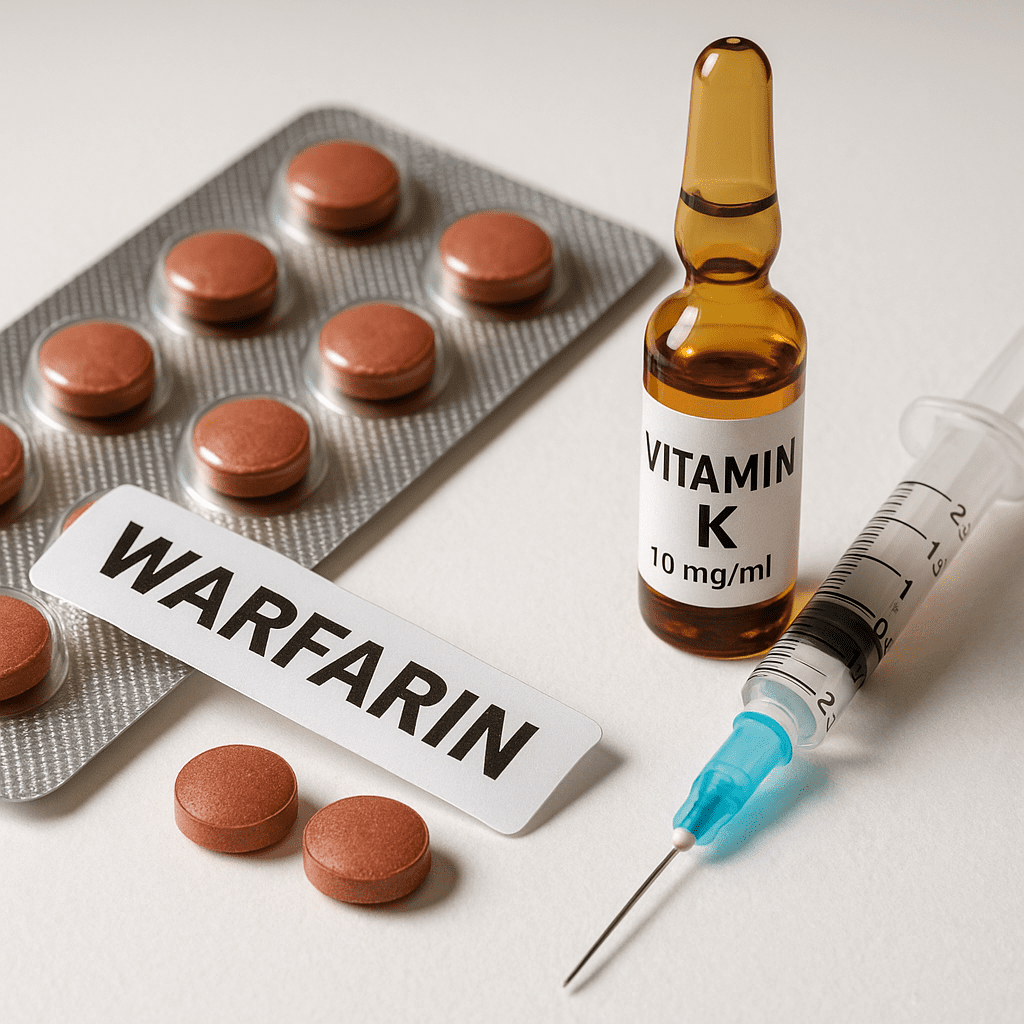
Quick Summary: How Vitamin K Affects Warfarin and INR
- Vitamin K directly influences INR, the key measure of blood clotting.
- Low doses (1–2.5 mg oral) are used when INR is elevated (4.5–10) but no bleeding is present.
- Higher doses (5–10 mg IV) are reserved for life-threatening bleeds.
- Overcorrection risks include warfarin resistance and thrombosis.
- Always adjust vitamin K dosage under medical supervision using guideline-backed strategies or a reversal calculator.
For related insights, explore our guide on Vitamin E and blood thinners hemorrhage risk.
Why the Warfarin–Vitamin K Interaction Matters
Warfarin is a vitamin K antagonist. It works by inhibiting vitamin K-dependent clotting factors, reducing blood’s ability to clot. That’s why vitamin K intake must be carefully managed in patients on warfarin.
When you add vitamin K — either through diet or supplementation — it can counteract warfarin, rapidly lowering INR and potentially triggering dangerous clotting. The goal is to correct INR safely without causing a rebound effect or warfarin resistance.
This is particularly critical for people with bleeding disorders, atrial fibrillation, mechanical heart valves, or stroke risk.
INR Management and Vitamin K Dosing Explained
How INR Levels Drive Dosing
| INR Range | Bleeding? | Vitamin K Dose | Route | Expected Response |
|---|---|---|---|---|
| 4.5–10 | No | 1–2.5 mg | Oral | INR reduction in 24–48 hrs |
| >10 | No | 2–5 mg oral or 0.5–1 mg IV | Oral/IV | Partial reversal in 12–24 hrs |
| Any INR | Major bleeding | 5–10 mg + PCC/FFP | IV | INR <1.5 in 2–8 hrs |
Dosing isn’t one-size-fits-all. It’s influenced by bleeding risk, urgency of reversal, and clinical setting. For minor INR elevations without symptoms, withholding warfarin alone may suffice. But in elderly or high-risk patients, even mild INR elevations warrant low-dose oral vitamin K for faster control.
Learn more about anticoagulant herb-drug interactions in our guide on Saw palmetto and blood thinner interactions.
IV vs Oral Vitamin K: Which Is Better?
- Oral: Slower but safer. Preferred for non-urgent INR correction. No risk of anaphylaxis.
- IV: Faster onset (within 6 hours), but used only for emergencies due to rare risk of severe allergic reactions.
A study in PubMed Central showed that 10 mg IV vitamin K achieved significant INR drops within 6–12 hours, but only 14.5% of patients reached target INR <1.5 at 24 hours without additional factor therapy.
How Vitamin K Dosage Affects INR Over Time
Low-Dose (1–2.5 mg oral)
- Lowers INR gradually by 2–4 points.
- Less likely to trigger warfarin resistance.
- Ideal for asymptomatic patients with moderately elevated INR (4.5–10).
High-Dose (5–10 mg IV)
- Rapid INR drop by 3–5 points in 6–12 hours.
- Required in emergencies such as intracranial hemorrhage.
- Often paired with prothrombin complex concentrate (PCC) or fresh frozen plasma (FFP).
- May induce warfarin resistance for up to 7 days.
Explore these findings in detail via the Circulation Journal’s warfarin reversal report and PubMed’s dosing comparison study.
Using a Vitamin K Dosage Calculator
Medical teams use reversal protocols and calculators to determine dosing based on:
- Current INR level
- Bleeding status
- Patient age and comorbidities
One guideline from Health Queensland recommends resuming warfarin at 50% of the original dose once INR falls below 5. This ensures smoother reinitiation and reduces risk of overcorrection.
To reduce interaction risks, consider certified interaction-safe multivitamins for polypharmacy.
Vitamin K Dosage Calculator
Always consult your healthcare provider before making changes.
Risks of Over- or Under-Correcting INR
Overcorrection Risks:
- Thromboembolic events (e.g., stroke, deep vein thrombosis)
- Warfarin resistance, requiring higher doses to restore anticoagulation
- Delayed re-stabilization of INR
Undercorrection Risks:
- Persistent bleeding risk
- Elevated INR-associated complications
Some studies, including those in the European Heart Rhythm Association Practical Guide, suggest tailoring vitamin K dosing especially in patients with liver dysfunction or malnutrition, which prolongs its effect.
Clinical Pearls: Personalized Dosing Is Key
- 1.25 mg oral vitamin K can reduce INR from >5.0 to <3.0 in 24 hours without major rebound.
- 10 mg IV vitamin K in life-threatening cases achieves reversal fastest, especially with PCC.
- Restarting warfarin too soon without INR monitoring may trigger a secondary INR spike.
Timing, route, and patient-specific variables all influence outcome — making calculator-guided care essential.
Conclusion
Managing the warfarin vitamin K interaction requires precision. For non-bleeding patients, low-dose oral vitamin K (1–2.5 mg) usually suffices. For critical bleeding, 5–10 mg IV with factor replacement provides the safest rapid reversal.
Be cautious of warfarin resistance with high doses and always resume therapy with clinical guidance.
For more support:
- Review our Vitamin E and blood thinners hemorrhage risk
- Track multivitamin compatibility via our NIH-backed interaction database app

